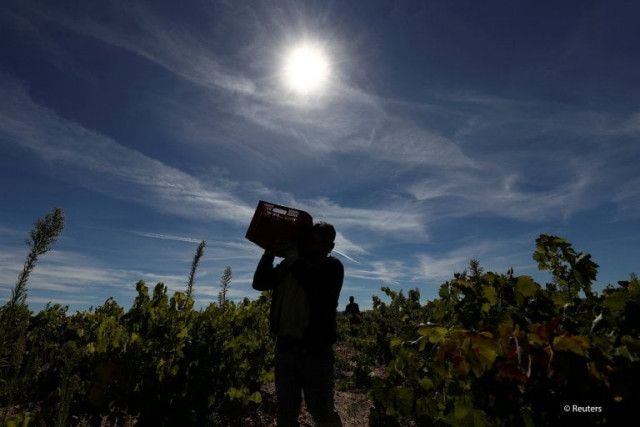Dual threats imperil Pakistan's agriculture sector
Locust swarm, Covid-19 puts food security at risk in Pakistan

A Reuters file image
The latest findings of the World Economic Forum (WEF) suggest a small swarm (on an area of one square kilometre) may contain up to 80 million locusts. They can consume the same amount of food in one-day as 35,000 people, while a large swarm can eat up to 1.8 million metric tons of green vegetation, equivalent to food enough to feed 81 million people.
“Pakistan has only one to two months to win the war against local swarms. After that more locust swarms may migrate to Pakistan from Africa,” Sindh Abadgar Board (SAB) Vice President Syed Mahmood Nawaz Shah said while talking to The Express Tribune.
The United Nations’ (UN) Food and Agriculture Organisation (FAO) has estimated agriculture losses of Rs500 billion to Pakistan from the locust attack. “The losses could be higher than the one estimated by the organisation (FAO),” he said.
The federal and provincial government should work together to win the war against the locust swarms attack, he said. Besides, delay in implementation of the announced subsidy of Rs37 billion on fertilisers is likely to further reduce per acre outputs during summer (Kharif) season.
“The uptake of fertiliser has reduced by 70% which may have a detrimental impact on Kharif production, as farmers are in final stages of sowing major crops of the season like cotton, sugarcane and rice season,” he said.
The government had announced the subsidy as part of its relief package worth Rs1.2 trillion to help people and business to fight against Covid-19 in April. Market talks suggest the subsidy was to implement through budget 2020-21. However, farmers are still waiting for the subsidy, he said.
He said the global health crisis has also contributed to the significant losses of farmers due to non-availability of transport to dispatch agricultural produces from fields to markets during the recent lockdown. The situation caused decaying of perishable items including vegetable and fruits. Farmers also sold major wheat outputs at a discounted price to avoid larger losses.
“Covid-19 caused a loss of around Rs15 billion on wheat sale in three months in Sindh alone. Majority of the wheat stocks was sold at an average of Rs1,320 per 40kg against the market rate of Rs1,580,” he said. Now, this is peak mango season and market talks suggest the export of the products is likely to fall by 50% this year. This will be another loss of farmers due to Covid-19, he lamented.
At an online meeting arranged by the Sindh Abadgar Board (SAB) earlier this week, a farmer has expressed locust attack and Covid-19 as the two largest threats to the food security in the country, he said.
Shah added that the federal and provincial governments have ignored the agriculture sector in the budget for FY21, as they avoided allocation of funds and measures to fight against the two single largest threats. He also urged upon the federal government to announce allocations for the second consecutive year.
The government had launched some 16 major projects under the five-year programme including increasing per acre agri outputs, increasing availability of water through increasing efficiency as 95% of the country’s water goes to the agriculture sector, creating import substitute of oilseeds, increasing food processing and storage capacity and fishing. It has been time and again presented to federal and provincial governments about import substitution of edible oil where Pakistan spends more than $3.2 billion. The import of edible oil and its seed has doubled since 2014-15. “In Sindh, the cultivated area of oils seed has declined from 260,000 hectares to 80,000 hectares,” he said.
No measures have been announced to arrest the decline in cotton production from 14.8 million bales five to six years ago to around nine million bales this year in Pakistan, he added.
Published in The Express Tribune, June 28th, 2020.
Like Business on Facebook, follow @TribuneBiz on Twitter to stay informed and join in the conversation.



















COMMENTS
Comments are moderated and generally will be posted if they are on-topic and not abusive.
For more information, please see our Comments FAQ